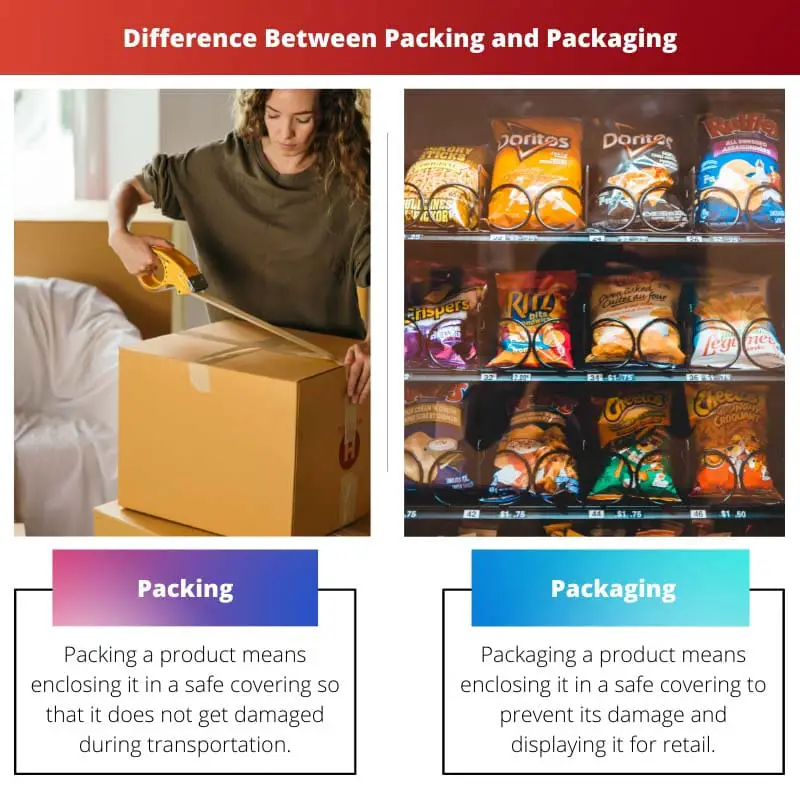The shipping industry has significantly grown over the past few years. With globally available services, what triumphs one product over the other is how attractive it looks.
The words packing and packaging fit into this fast-paced marketing world. People regard them as synonyms.
However, they are very different in meaning and cover.
Key Takeaways
- Packing is putting items into a container or wrapping them for protection or transportation. At the same time, packaging is the overall design and production of containers, labels, and wrapping materials used to present and protect products.
- Packing focuses on arranging and securing items for transport or storage, while packaging involves the development of visual and functional elements that improve consumer appeal and protect product integrity.
- Packing is a logistical task, while packaging encompasses both creative design and technical considerations.
Packing vs Packaging
The difference between packing and packaging is that packing is merely for protecting the product, whereas packaging is for both protection and endorsement.

Packing is the protective covering for a single product or many similar products. It may be an ordinary cardboard box without any details regarding the product.
Packaging a product is the onus of the manufacturer, who will try to make the cover as attractive as possible so that the profit is eventually maximized.
Comparison Table
| Parameter Of Comparison | Packing | Packaging |
|---|---|---|
| Definition | Packing a product means enclosing it in a safe covering, so it does not get damaged during transportation. | Packaging a product means enclosing it in a safe covering to prevent damage during transportation and displaying it for retail. |
| Primary Aim | Packing a product aims to render it safe for transportation to retail stores. | Packaging a product aims to make it visually appealing for a potential buyer. |
| Displayed Information | No product information except the reference number of the carton is displayed when packing. | Cost price, manufacturer, representative images, and other information are displayed when product packaging. |
| Related Fields | Packing applies to the fields such as medicine, agriculture, chemistry and more. | Packaging is strictly used in the marketing and advertising industry. |
| Companies Engaged | In packing, general transport and shipping companies are engaged. They are not bothered about the brand of the product. | Packaging engages individual brands that prudently decide the look of their product. |
What is Packing?
Packing covers a product with a protective case to prevent its damage during transportation. The covering may be of plastic, cardboard, or metal.
Packing a product aims to transport it safely to the retail stores. There may be many products of the same brand in cardboard packing.
The packing only contains the reference number and no other information about the product inside.
General shipping companies are hired to pack and transport the material by the manufacturer. These companies may be lending services to many brands at the same time.
Packing comes under the category of a general act too. It can be used in speech as packing luggage or a gift.

What is Packaging?
Packaging is designing and packing a product for sales and storage. The look of a package is crucial because it decides the visual popularity of the product.
The main aim of packaging is to attract the customer. Protection is a secondary aim in this case.
Packaging includes many types, such as anti-corrosive, pharma, plastic, and flexible. These types are chosen according to different fields that use packaging.
The package for a product contains essential information such as the product’s name, details of manufacture, price, et cetera. Marketing companies mainly design logos and other visuals for the product.
A recent finding suggests that the share in packaging for Asia, North America, and Western Europe is 36%, 23%, and 22%, respectively.

Main Differences Between Packing and Packaging
Packing and packaging sound and are similar in some aspects. They, however, have subtle differences. These are :
- Packing is used to transport several products of the same brand together. On the other hand, packaging provides safety to a single product only.
- The main aim of packing is the safe transportation of the product, whereas the main objective of packaging is to make the product visually appealing to the customer.
- No information about the product is displayed on its packaging. On the other hand, important information, such as the product’s name, date of manufacture, and expiry date, is displayed on a product’s package.
- Packing is used strictly for shipping and transporting a product, whereas packaging supports the designing and handling of the product.
- Public companies that provide shipping services are engaged in packing. On the other hand, manufacturing, designing, and advertising companies are engaged in packaging.

- https://onlinelibrary.wiley.com/doi/abs/10.1111/j.1745-4557.1987.tb00859.x
- https://journals.aps.org/prl/abstract/10.1103/PhysRevLett.96.208102

A thorough delineation of the differences, though the absence of a discussion on contemporary trends or future prospects is quite conspicuous.
Rightly pointed out, an exploration of the evolving dynamics in the shipping and marketing realm would supplement this discussion effectively.
Your observation is astute, an inclusion of such an analysis would make the article more comprehensive.
This article elaborately explains how packing and packaging differ in meaning and purpose, offering valuable insights about the shipping and marketing industry.
Indeed, the distinction is crucial for effective product presentation and delivery.
The comparison is astute, providing a deeper understanding of the core concepts.
A comprehensive and informative article, it has enriched my understanding of the nuances between packing and packaging.
I totally agree, the article provides a clear distinction between packing and packaging.
A notable distinction between the two terms, vividly explained, yet lacks practical implementation scenarios to fully illustrate the concepts.
I concur, some real-world examples would indeed offer a practical dimension to the theoretical constructs explained.
Although the article is informative, it lacks real-world case studies or examples to facilitate better understanding.
You bring up a valid critique, perhaps future iterations could incorporate such content.
I see your point, some practical illustrations could enhance its effectiveness.
An impeccably elucidated comparison, provoking profound reflections, yet an element of humor or satire could possibly enhance its engagement.
I understand your point, a touch of lightheartedness might indeed make the complex subject more approachable.
The suggestion of adding humor is quite intriguing and could render the article more appealing to a wider readership.
An intriguing delve into the semantics of packing and packaging, providing a fundamental knowledge-base for industry enthusiasts.
Absolutely, the depth of understanding this article offers is commendable.
Well articulated points, backed by scholarly references, making it a robust piece of literature.
The article is somewhat pedantic in its approach, possibly limiting its accessibility to non-scholarly audiences.
I agree, an effort to simplify the language used could make it more inclusive.
The comparison table aids in effectively outlining the differentiation between packing and packaging, a commendable addition to the article.
Absolutely, it’s a pragmatic approach to summarizing the core distinctions.
True, the tabular representation enhances clarity and comprehension.
An insightful analysis, the article brings to light the primary differences between packing and packaging and how they shape the wider shipping industry.
Agreed, understanding this distinction is essential for all stakeholders involved in shipping and product marketing.
I found this article very helpful, it helps clarify concepts that are misunderstood.